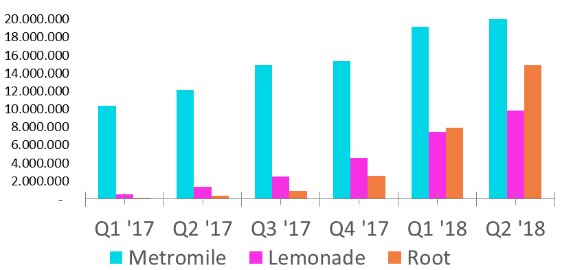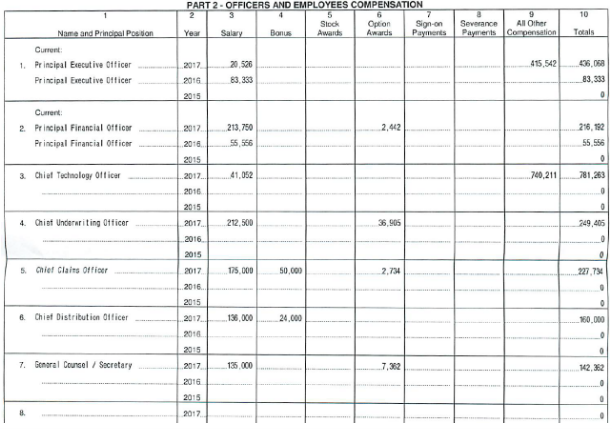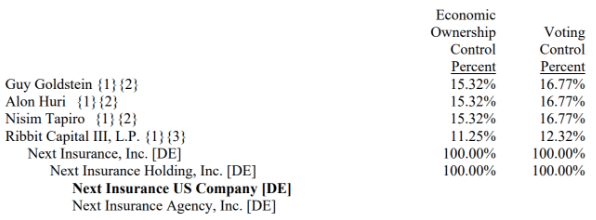Important Perspective for Insurance Agents
New legislation says that only "natural" persons must carry a license -- so, AIs can do whatever they and their creators want.

New legislation says that only "natural" persons must carry a license -- so, AIs can do whatever they and their creators want.

Get Involved
Our authors are what set Insurance Thought Leadership apart.
|
Partner with us
We’d love to talk to you about how we can improve your marketing ROI.
|

Chris Burand is president and owner of Burand & Associates, LLC, a management consulting firm specializing in the property-casualty insurance industry. He is recognized as a leading consultant for agency valuations and is one of very few consultants with a certification in business appraisal.
Submitting an MSA to CMS for review and approval builds in unrealistic costs that can double the expenses for the workers' comp payer.

Get Involved
Our authors are what set Insurance Thought Leadership apart.
|
Partner with us
We’d love to talk to you about how we can improve your marketing ROI.
|

Deborah Watkins is the former CEO of Gould & Lamb, the global leader in full-service Medicare Secondary Payer Compliance. She has worked closely with the Centers for Medicare and Medicaid Services (CMS) and congressional staff advocating for improvements in the Medicare Secondary Payer program.
With an insurtech revolution already starting, how long will it be before the likes of Amazon and Google enter the home market in a serious way?

Amazon has made no secret of its intent to disrupt virtually every industry on the planet, most recently announcing a partnership with JPMorgan Chase and Berkshire Hathaway to create an independent healthcare company. Reportedly, the retail giant has also begun to explore the idea of setting up an insurance price comparison site in the U.K.
The formula is now clear. Amazon and other consumer-first digital disruptors like Google set their sights on a conventional industry with aging distribution and marketing channels, then things start to change rapidly. With an insurtech revolution already starting to brew in the home insurance marketplace, how long will it be before the likes of Amazon and Google enter the market in a serious way? And, if they do, will customers welcome them?
While industry incumbents like State Farm, Allstate and Progressive have begun to speculate on potential scenarios for this kind of digital disruption, J.D. Power’s P&C insurance industry practice went right to the source – the consumer – to ask how real home insurance customers would feel about the presence of tech companies in this space.
Following were the key findings from the J.D. Power Pulse Survey:
20% of Consumers Would Use Amazon or Google for Home Insurance The data revealed that 20% of consumers would use an Amazon or Google for their home insurance. Millennials showed even higher interest at 33% for Amazon and 23% for Google. Of those who indicated that they would be willing to switch, 80% currently have insurance with a large national carrier.
See also: What if Amazon Entered Insurance?
75% of Consumers Interested in Home Telematics While most of the media’s attention has focused on the future of automation technology in automobiles, the disruption to your home experience – and by extension your home insurance – through smart home technologies is likely to have an equal or greater impact. Smart home technologies are revolutionizing many areas of the home, from simple comfort features that can now turn lights on and off or access in-home entertainment by control of your phone to home security and emergency support with automatic shutoffs and alerts.
The insurance industry wants in on the action. Insurers see smart home technologies as an opportunity to deepen their relationships with customers, while improving home coverage options and underwriting. While leading home insurance carriers have begun to venture into these areas, not much research has been done to understand the consumer’s demand as these features become available.
Based on the J.D. Power Pulse Survey, following are insights into the current consumer appetite for this type of technology:
See also: 5 Misunderstandings on Home Insurance
Get Involved
Our authors are what set Insurance Thought Leadership apart.
|
Partner with us
We’d love to talk to you about how we can improve your marketing ROI.
|
Policy data migration can deliver mature books of business to new policy handling systems and decommissioning of legacy systems.

 Below are some points to consider when designing insurance policy data migration, paired with some experience-based points of view.
1. Target system/s and architecture should be built so that policy data migration can be effective:
Below are some points to consider when designing insurance policy data migration, paired with some experience-based points of view.
1. Target system/s and architecture should be built so that policy data migration can be effective:
Get Involved
Our authors are what set Insurance Thought Leadership apart.
|
Partner with us
We’d love to talk to you about how we can improve your marketing ROI.
|
It would be foolish to think that Amazon, et al. will enter the industry to play nice and simply serve as brokers or lead generators.

Get Involved
Our authors are what set Insurance Thought Leadership apart.
|
Partner with us
We’d love to talk to you about how we can improve your marketing ROI.
|

Ever since the early 1980s, I've been hearing about how Silicon Valley was passé, soon to be duplicated in other parts of the world and ultimately supplanted. So I've become more than a little jaded as the years have passed and the valley has not only thrived but has spread south toward San Jose and positively taken over San Francisco. The valley has even spread across the Bay Bridge and is heading east. I have a daughter trying to find an apartment in Oakland, and...yikes, it's expensive.
But Silicon Valley has planted the seeds of its own irrelevance, and it's time to start planning for what comes next. Certainly, incumbents like those in insurance need to move past the Silicon Valley model.
I'm not saying that another location—Chicago's Silicon Prairie or New York's Silicon Alley—will take its place, but the sorts of communication tools developed in the valley make it a lot easier to communicate with investors, so startups don't need to cluster around Sand Hill Road any more. The cloud, another gift from the valley (and its northern outpost, Seattle), means computing power is plentiful and cheap. Money is everywhere. The success of the valley's venture capitalists has made sure of that, and hot startups have seeded certain areas—Doubleclick multimillionaires in New York, Groupon multimillionaires in Chicago, Baidu and Alibaba multimillionaires throughout China. Expertise and the entrepreneurial spirit have spread, too. Stanford and Cal no longer have a lock.
The expense of the valley will also tend to drive people away. If you don't absolutely have to be in the valley, why not set up shop in places your people can afford: like Ohio, as Silicon Valley star Mark Kvamme did, or Washington, DC, as AOL's Steve Case did? The bar at the Rosewood Hotel in Menlo Park is quite the scene on Friday night, but you can get your Clase Azul tequila for a lot less elsewhere.
Even more important from the standpoint of insurers, the Silicon Valley model doesn't fit that well. For one thing, most of what we think of it is myths (which Vivek Wadhwa does a nice job of debunking here). For another, insurance can't be transformed just by a bunch of computer scientists, no matter how smart. Industry knowledge is required more than in perhaps any field this side of medicine—as Zenefits learned the hard way. The Silicon Valley ethos of "move fast and break things" (as memorably summarized by Facebook) doesn't work in insurance, either. Regulators won't let you break things, nor should they when we're talking about something like a person's health insurance or life insurance. Finally, the valley's alpha approach has led to rampant issues with sexism, as summarized in the recent book "Brotopia."
Why, then, is there still so much "innovation tourism" to Silicon Valley as insurers look there for answers to their innovation questions?
A different model is needed. It must draw on the audacity of Silicon Valley and its ability to take out a clean sheet of paper and reimagine almost anything. But the model must also fit within the regulatory environment of insurance, within the structure of incumbents and their insurtech partners and within insurance's peculiar constraint: that you often can't know your cost of goods until years or even decades after you sell a policy.
Helping define that model is what keeps us excited about ITL and about our Innovator's Edge platform. We hope you're excited, too.
Have a great week.
Paul Carroll
Editor-in-Chief
Get Involved
Our authors are what set Insurance Thought Leadership apart.
|
Partner with us
We’d love to talk to you about how we can improve your marketing ROI.
|

Paul Carroll is the editor-in-chief of Insurance Thought Leadership.
He is also co-author of A Brief History of a Perfect Future: Inventing the Future We Can Proudly Leave Our Kids by 2050 and Billion Dollar Lessons: What You Can Learn From the Most Inexcusable Business Failures of the Last 25 Years and the author of a best-seller on IBM, published in 1993.
Carroll spent 17 years at the Wall Street Journal as an editor and reporter; he was nominated twice for the Pulitzer Prize. He later was a finalist for a National Magazine Award.
Recent tests cast doubt on the efficacy of driver-assist technologies and thus on how soon full autonomy is likely to affect auto insurance premium.

 Source: NHTSA https://www.nhtsa.gov/technology-innovation/automated-vehicles-safety[/caption]
Source: NHTSA https://www.nhtsa.gov/technology-innovation/automated-vehicles-safety[/caption]
Notice that Level 2 is a long way from Level 5.
Get Involved
Our authors are what set Insurance Thought Leadership apart.
|
Partner with us
We’d love to talk to you about how we can improve your marketing ROI.
|

Donald Light is a director in Celent’s North America property/casualty insurance practice. His coverage areas include: technology and business strategy, transformative technologies, core systems and insurance technology M&A due diligence.
If insurers use the same words and wield the same pallet of primary colors, they will be too generic to be memorable and too guarded to make a sale.

Get Involved
Our authors are what set Insurance Thought Leadership apart.
|
Partner with us
We’d love to talk to you about how we can improve your marketing ROI.
|
Growth at Lemonade, Root and Metromile may be slowing. Is the reason issues with customer acquisition or a focus on underwriting profitability?

Summary
Context
The networking tips from the great Spanish swordsman Inigo Montoya got us thinking about the insurtech startups climbing the Cliffs of Insanity. While the lumbering incumbents are indeed powerful giants and have a head start on the climb, they are also carrying lots of weight.
The venture-backed, full-stack U.S. insurtech startups continued to gain in the second quarter through rapid premium growth and moderately lower underwriting losses. But they have yet to show the ability to win at a sword fight, battle of wits or ROUS attack or to generate a sustainable loss ratio under 100%.
This is the third installment of our review of U.S. insurtech startup financials. Here are the 2017 edition and first quarter 2018 edition, which generated many social media discussions. For more information on where our data come from and important disclaimers and limitations, see the 2017 edition.
Our scope is only property & casualty companies, so we don’t cover life, health (sorry, Mario), mortgage and title (sorry, Daniel). As before, we respect the management teams highly and admire these companies for earning the right to call themselves an “insurance company” -- more on that below.
To date, we have tracked the three independent P&C startups most commonly associated with the label "insurtech": Lemonade, Metromile and Root. This quarter we’ve looked at newly licensed Next Insurance (which wrote no premium) plus four subsidiaries of larger companies with a direct or insurtech focus.
Overall results
For the real insurance nerds, here is a summary of the 2Q18 statutory financials of three venture-backed insurance companies. Only “insurance companies” have to file statutory results, not agents and brokers (i.e., most insurtech underwriters), which are not “insurance companies.” We present the summary here and quarterly details on each of the venture-backed companies at the very bottom.
And here are the four subsidiaries of big companies that are selling direct or have a claim on being an insurtech. These companies often depend on parents for reinsurance and infrastructure, so we show mainly the gross figures.
Growth rates remain robust but may be slowing a bit – are there issues on customer acquisition, or are carriers focusing more on underwriting profitability?
Absolute growth was led by Root, which nearly doubled its quarterly gross premium written in three months. Our composite grew at 37% quarter over quarter, but most of the companies had their slowest or second-slowest quarter in the last six.
Is this a slight slowing trend? Maybe. Some of the carriers may be seeing seasonal effects. If the pace of growth is really showing the first signs of slowing and not just a blip, the question is whether the slower growth is despite insurers’ efforts to grow or if they are deliberately focusing on profitability. The CEOs of Root and Lemonade have hinted that they are focusing more on underwriting (here, here), so is this affecting growth rates? Here is a point/counter-point. Decide for yourself.
See also: The First Quarter in Insurtech Financials
Point: Insurtechs are finding growth more difficult
Counter-point: Insurtechs could grow faster but are throttling growth to focus on profit
The LCMF is a Loss Cost Modification Factor, and higher LCMFs may indicate higher pricing. In spot-checking some of Lemonade’s recent filings, we find that it is still filing a $5 minimum rate but is pricing higher than incumbents such as State Farm in certain zones, perils, etc. The company’s frequency being higher than average could be a function of (1) a bot-driven claims system inviting fraud, (2) having shlimazels for customers, (3) problems with the coverage or form or (4) the behavioral economics assumptions not working as intended.
Recall Lemonade saying: “If you tried to create a system to bring out the worst in humans, it would look a lot like the insurance of today … We’ve spent recent years deepening our understanding of honesty and trust ... Lemonade aims to reverse the adversarial dynamics that plague the industry, transforming both the economics and experience of insurance.”
What do you think?
Status of the climb up the Cliffs of Insanity (direct premium written) 
Focusing on the protagonists of our previous analysis Bigger and Redder, Root’s extraordinary growth means it has opened a big gap on Lemonade and is closing the gap with Metromile. This dynamic has helped Root achieve unicorn status, with the last $100 million round of funding at the iconic $1 billion valuation. Root is not the first insurer to test a “try before you buy” (TBYB) approach based on an app, but it is the first insurer in the world to build a sizeable portfolio that way. Will Root succeed where others have abandoned their efforts or chosen different approaches such as usage-based pricing or discounts at renewal?
We commend Root for hitting the symbolic unicorn status so quickly. It appears to have a few years of runway to prove its model. By the time of an exit for the most recent investors, we believe that Root will be evaluated in greater part on the traditional KPIs that we look at in our analysis.
A few weeks ago, Bain Capital – we are Bain & Co. alumni – offered $1.55 billion to buy Esure, a P&C insurer (mainly motor) selling online in the U.K. Esure wrote £880 million (annualized) premium in the first half of 2008 (or about US$1.1 billion) -- and did so at a profit. Looking very simply at price-to-sales ratio (though we prefer ROE and price-to-book), Esure sold a bit over 1.4X, which simplistically corresponds to $700 million of premium for a valuation of $1 billion. Investors will need Root’s management to continue to grow rapidly – their 2Q18 run rate is $60 million.
Whether they can do so, and achieve profitability along the way, will be a bellwether for demonstrating if current valuations are a bubble or smart bets on a rapidly changing industry. Root’s $1 billion valuation (looking abroad, Chinese startup carrier Zhong An has a $7 billion valuation despite a 124% combined ratio in the first half) should cause companies in low-margin commodity lines like home/renters and auto that are operating as MGAs to consider becoming a carrier.
One of the strongest arguments for being an MGA, not a carrier, is that MGAs are more highly valued because they trade on a multiple of earnings rather than book value. For the time being, the most valuable recent startups in insurance underwriting appear to be carriers, not MGAs.
Gross loss ratios are generally stable or improving slightly but still unsustainable
We prefer to look at gross loss ratio, i.e. before any premiums and losses are ceded to reinsurers, because sticking losses to reinsurers isn’t a sustainable long-term strategy. Eventually, gross loss ratios need to be sustainable. This quarter’s numbers are basically unchanged since last quarter, though Lemonade and Metromile have adverse development in this quarter, which raises the reported loss ratio.
If our subject companies are shifting management attention toward profitability, it is not yet obvious in the figures. Improving underwriting results is like steering a slow-moving boat. You can turn the tiller, but the boat may not go the way you want, and it will take some time. Insurance policies last a year, rates are regulated by states and unsettled old losses can get worse if the legal environment changes.
Of the three venture-backed startups, Metromile’s figures have always shown the greatest profitability, and the company shows an improvement on the last quarter, shaving four points off the loss ratio. Not all startups are experiencing unsustainable loss ratios. Hippo -- a homeowner’s MGA -- claimed to have produced better-than-market underwriting straight out of the gate, although we have no way to verify this.
Conference chatter is increasingly turning to profit, not just premium. We welcome these signs of maturity in the insurtech market, which were a big reason we started writing these articles and presenting at conferences.
Industry veterans are outperforming the newbies on loss ratio but not premium growth.
Two of the startup carriers sponsored by highly regarded underwriters are performing very well in terms of profit. BiBerk, which ultimately reports to Ajit Jain, recorded a respectable 70% gross Loss & LAE ratio in the quarter. Intrepid, where Rob Berkley sits on the board, turned in a 60% loss ratio (without LAE). Neither company has cracked even $4 million in quarterly premium, compared with Root at nearly $15 million, but is there something that Ajit and Rob know that the newbies don’t? Or are big public companies just less motivated to grow than venture-backed companies? Or is growth first really the right answer?
We’re not showing State Farm’s HiRoad entity because we’re less clear on how it reports and is managed by State Farm’s executives.
It will still take several years to become a scale insurer
All three venture-backed insurers increased expenses in the quarter. Root lost $11.6 million, a burn rate of $129,000 every day. That still gives two years of runway if the burn rate can be maintained. We get details on expenditures only in annual statements, so we cannot know for sure whether Root is spending on headcount, advertising or other overhead. LinkedIn pegs the company’s headcount at 117, with 30 people joining just in the second quarter.
The company runs a referral program that has paid $860,000 to date. We speculate that $25 is the average referral bonus (so $50 because both parties get the bonus), which equates to 17,000 referrals. If the average premium is $750 (again, a guess; a bit below the national average), then the referral program has generated more than $13 million of premium at a CAC of $50, which would be an impressive 40% of all the premium in these first 18 months.
As the company expands exponentially to grow into its unicorn valuation, the question for investors is if the company can maintain exponential growth and bring down the loss ratio simultaneously, so growing without raising losses exponentially. It’s a difficult balance.
In the meantime, investors added $45 million to the insurance company’s statutory surplus, but -- because of losses -- surplus stands at $43 million at the end of the quarter.
Root’s CEO says that the company is getting better at pricing and predicting the business, and that “conservativeness” in reserves means prior results were better than they appeared. We agree with Root that there is increasing evidence of conservative reserving, but not based on the figure it cited in the blog. Root says that only 66 cents on the premium dollar was paid as claims in 2017 (net) – which appears to exclude payments expected for open claims and losses incurred but not reported (“IBNR”). The more meaningful number, in our view, is that Root has recorded $344,000 of favorable development this year -- meaning it has decided that its estimates of prior-year losses were indeed too high.
The company earned $792,000 of premiums in 2017 and stated losses at Dec. 31, 2017, at $1.3 million, for a net loss ratio of 168%. If 2017 actual losses were in fact $986,000, as they are now estimated, then the developed loss ratio would be 124% -- which is better but doesn’t greatly change the overall view of the year, which was small and volatile and hence of limited use to understand the company (but the best any outsider had at the time).
Root also deserves credit for being the only one of the three venture-backed companies to have made conservative loss picks. Lemonade continues to see its reserves be inadequate. The company had $2.1 million of reserves at the start of the year and has seen $245,000 of adverse development this year. Even a more experienced underwriter, Metromile, started the year with nearly $14 million of reserves and has recorded nearly $1.5 million of adverse development.
Stepping back from the noise of quarterly reserving, we still believe that the companies have to prove underwriting quality and do so with sustainable overheads and expenses. There’s still a long journey ahead, but the companies have the resources (in the form of cash at the holding company) to work on the challenge for years to come.
Reinsurers continue to subsidize losses
Lemonade continues to hand reinsurers $3.61 of losses for every $1 in premium in the quarter. Root handed reinsurers $1.41 of losses for every $1 in premium. Metromile -- as with other metrics -- is playing a safer game, and its reinsurers even made a bit of money in the quarter, getting $0.86 of losses for every $1 in premium.
Root disclosed that it changed its reinsurance program, reducing its quota share from 50% to 25% of premium effective June 1 through the remainder of 2018, meaning it will keep more premium (and losses) and possibly get less capital relief. The company retains a $1M xs $100K per-risk excess of loss treaty(*). Terms were not disclosed. (*)
Explanation of reinsurance basics: In quota share reinsurance, an insurer reinsures a percentage of its book – a fixed percentage of every dollar of premium and loss. The reinsurer pays the insurer a ceding commission to cover the insurer’s expenses and may assume unearned premiums (a liability), which may increase the insurer’s statutory capital. In excess-of-loss reinsurance, the reinsurer covers every dollar above a certain amount (the attachment point) up to a pre-defined limit. Excess of loss reinsurance can be written per event (such as a storm) or per risk.
In Root’s per-risk reinsurance, the reinsurers appear to take each and every loss of more than $100,000 to the extent that the loss exceeds $100,000, up to $1.1 million. Here is a technical resource on the subject of using reinsurance for capital optimization.
See also: Can Insurtech Rescue Insurance?
Executive compensation appears to be as expected -- likely mostly in stock
Many insurers are required to file an annual Supplemental Compensation Disclosure listing the name, title and compensation of their top 10 executives. The requirement was triggered by an investigation in 1905. (Here’s some trivia for a cocktail party at InsureTech Connect: That’s the same year Las Vegas was founded.) The state of Nebraska will mail the information for all companies that operate in Nebraska to anyone who sends them $80. The hardest part is finding a computer with a CD-ROM drive.
This is a sore point among insurers (the disclosure, not the need for a CD-ROM). Some insurers risk a fine instead of being transparent, such as by putting zeros for their compensation or putting a blank piece of paper over the data before mailing it. We like numbers, and there are reasons for the disclosure in an insurance context. Most insurers are subject to extensive regulation and disclosure of their rates, which need to be reasonable, which means not paying executives excessively and passing costs through in the rate. And, as Lemonade says, insurance is a business of mutual trust, which requires reasonable executive compensation practices, even if not overseen by shareholders. For more on the disclosure, click here.
Lemonade and Metromile are required to complete the disclosure, though Lemonade’s commitment to transparency doesn’t extend to putting the required names on the form. Their disclosures are below. The numbers are not huge -- indeed, they are within what one would expect for a startup, where founders and early joiners get big equity grants with salaries that pay the bills but are often dramatically less than what a senior executive at an insurer typically earns. Interestingly, two of Lemonade’s founders sold shares in 2017, which is reflected under “all other compensation.” Metromile seems to have forgotten a few figures in its filing. Note that both Lemonade and Metromile “allocate” compensation to companies within their holding company system, and in absence of information on how this allocation works, it is possible that these figures are materially understated because of the allocation.
Here is Lemonade Insurance:
 Metromile Insurance:
Metromile Insurance:  One last note on compensation. Metromile filed its disclosure electronically, while Lemonade apparently walked down to the Post Office. We don’t know how to explain why a high-tech company like Lemonade would use snail mail. It mailed the disclosure on March 1, a Thursday, so it must have been #TBT in Lemonade’s offices.
One last note on compensation. Metromile filed its disclosure electronically, while Lemonade apparently walked down to the Post Office. We don’t know how to explain why a high-tech company like Lemonade would use snail mail. It mailed the disclosure on March 1, a Thursday, so it must have been #TBT in Lemonade’s offices.
Next Insurance U.S.
Digital small business insurer Next announced in May a plan to form a new carrier, and it has. The company was formed in September 2017, which indicates that the plan will have been in the works for a year before the carrier writes business. Next’s filing was all zeros except the surplus (or equity) in the company, which is more than $10 million. As of November 2017, the company’s business was described as follows: “The Company will initially offer Contractors Insurance in three levels of coverage for 190 classes including Handymen, Carpenters, Electricians, HVAC Technicians, Landscapers, Janitors and Plumbers. All Contractor Insurance plans will include general liability ($5 million limit), professional liability ($3 million limit) and inland marine ($3 million limit) coverages. The Company will eventually write other types of small business classes including restaurants, daycares, personal training and photographers. These products are currently produced by licensed producers of Next Parent on other insurance carriers’ paper. … The company will eventually offer the following additional types of commercial insurance to small businesses with $3 million maximum limits, unless indicated otherwise: commercial property, commercial auto, director and officer liability, employment practices liability, business interruption, surety bond ($1 million limit), liquor liability, cyber, data breach ($5 million limit). The Company’s planned net retention for all lines will be 20% of the maximum limits.” The remaining 80% of limits will be ceded to Munich Re Americas (MRAm). The company’s directors are Guy Goldstein (the CEO), Nisim Tapiro (co-founder) and Dawn Puro. As of November 2017 (before the most recent $83 million fundraising), the company’s ownership was as follows: 
What’s in a name?
A recent startup proclaims: “[Company name] Insurance is a [line of business] insurance company that provides [line of business] coverage to small businesses through a simple online experience. Offering A.M. Best A-rated insurance… direct to customers since 2018...” That wording makes consumers think they’re dealing “direct” with an insurer, not an agent or broker, which is what this company is. Words matter in insurance, as illustrated in the first section of the California Insurance Code.
#themoreyouknow “Congratulations, you’re innovating in a highly regulated industry”
Still on the subject of regulation, let’s have some fun with deficiency letters. Part of the joy of getting a new insurance program licensed in a new state is the exchanges with regulators. The insured makes a filing of a few hundred pages, the state reviews it and states its objections, and ‘round we go for, potentially, months. If you’re an insurance nerd, you might find these letters interesting. Particularly Lemonade’s, if only because of how the sausage-making of insurance contrasts with public statements about doing better for consumers.
A recent letter from Oregon to Lemonade had language like this: "Please explain why the insurer is choosing such broad exclusionary language; and if possible, provide an example of why this is necessary to have." Hmm… A letter from Virginia last month listed nine pages of objections, even objecting to Lemonade’s definition of “hovercraft.”
A sample of the objections: "The Company will need to withdraw under the Special Limits, items (g), (h), (i), (j), and (k). The limitations the Company has outlined in these sections are more restrictive than the provisions in the minimum standards set forth in the [Virginia Administrative Code]. It is not permissible for the Company to place limitations or impose special limits that are more restrictive than the minimum standards set forth in the VAC. For items h and i, it is acceptable to impose a special limit or to exclude business property but it is not acceptable to impose a special limit or to exclude property used for business purposes. For example, if I take my laptop (business property) home to do some work, the business property can be limited or excluded. However, if I use my personal computer at home to do some Bureau of Insurance work, that is personal property being used for a business purpose and coverage cannot be limited or excluded." Score a point for the Virginia Bureau of Insurance for using human language.
All this, and we haven’t even gotten to Policy 2.0. Maybe dealing with U.S. regulators is why Lemonade is now keen on international expansion?
Meanwhile, the interviewers at Bloomberg TV have been reading our articles.
See also: Startups Take a Seat at the Table
Looking forward
The third quarter, which includes most of the summer, could be a big one for the companies in our coverage, because insurance often changes when people move. We are gratified by the increasing focus on insurance fundamentals in insurtech, and the lofty valuations recently seen in the sector will require satisfying both venture metrics as well as solid insurance fundamentals. The startups have the time and the resources but a long way to go to climb the Cliffs of Insanity. They are gaining on the incumbents, but will they make it to the top of the cliffs before running out of power? It’s not inconceivable.
This article was written by Matteo Carbone and Adrian Jones.
Get Involved
Our authors are what set Insurance Thought Leadership apart.
|
Partner with us
We’d love to talk to you about how we can improve your marketing ROI.
|

Matteo Carbone is founder and director of the Connected Insurance Observatory and a global insurtech thought leader. He is an author and public speaker who is internationally recognized as an insurance industry strategist with a specialization in innovation.
Using AI, here are three ways to transform workers' comp claims from lose-lose to win-win for both companies and injured workers.

Get Involved
Our authors are what set Insurance Thought Leadership apart.
|
Partner with us
We’d love to talk to you about how we can improve your marketing ROI.
|